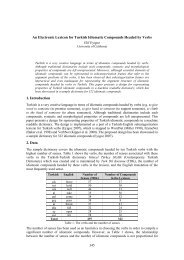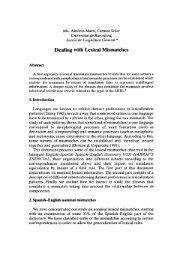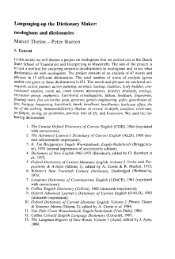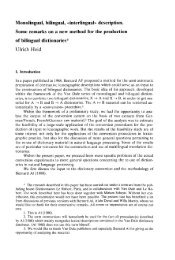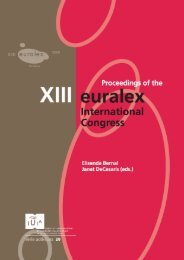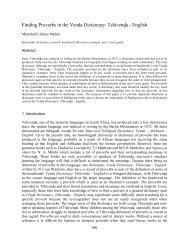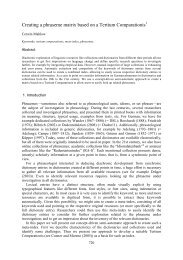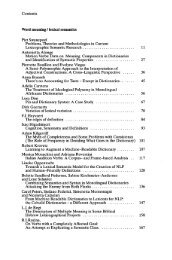Collocations in a New Bilingual Print and Electronic English - Euralex
Collocations in a New Bilingual Print and Electronic English - Euralex
Collocations in a New Bilingual Print and Electronic English - Euralex
You also want an ePaper? Increase the reach of your titles
YUMPU automatically turns print PDFs into web optimized ePapers that Google loves.
EüRALEX 2002 PROCEEDINGS<br />
<strong>Collocations</strong> as Example Sentences<br />
Occasionally, a collocation cannot be shown neutrally, due either to its complex structure (<strong>in</strong><br />
either L1 or L2), awkwardness <strong>in</strong> translation or the position ofthe base (see section 4.1) or<br />
when the collocation is only used <strong>in</strong> a certa<strong>in</strong> sentence mode. In these cases, the collocation<br />
is shown <strong>in</strong> an example sentence as the follow<strong>in</strong>g examples show:<br />
not:<br />
*bulge ...to~<strong>in</strong>sth<br />
*bulge ... to ~ <strong>in</strong> surprise<br />
but rather<br />
bulge ... v... her eyes ~d <strong>in</strong> surprise vor Überraschung fielen ihr die Augen fast aus dem Kopffam;<br />
not:<br />
*behave ... to ~ someway towards sb sich irgendwie jdm gegenüber verhalten;<br />
but rather:<br />
behave ... vi... How did he ~ towardsyou? Wie hat er sich die gegenüber verhalten?;<br />
not:<br />
*ask<strong>in</strong>g ... to be sb's for the ~: jem<strong>and</strong> kann etwas haben wenn er möchte;<br />
but rather<br />
ask<strong>in</strong>g ... n ... it'syoursfor the ask<strong>in</strong>g du kannst es haben, wenn du möchtest;<br />
Space-Sav<strong>in</strong>g Devices<br />
In pr<strong>in</strong>t products, one must deal with the problem of limited space for a phenomenon as vast<br />
as equivalence. When the base has beenjudged to be easy to translate <strong>in</strong>to L2 either on the<br />
basis ofthe user's language competence or a look-up under the appropriate headword, the<br />
base is given <strong>in</strong> italics <strong>and</strong> only the collocate translated:<br />
abortive ... adj... (not successful) attempt gescheitert;p/aH misslungen;<br />
accus<strong>in</strong>g ... adj... look anklagend attr\ tone vorwurfsvoll;<br />
record ... vt ... tfor later reproduction) 4 to ~ sth FILM, MUS etw aufnehmen; event etw<br />
dokumentieren; to ~ a speech e<strong>in</strong>e Rede aufzeichnen;<br />
In the example, record, the only collocation deemed worth the space of list<strong>in</strong>g it explicitly<br />
was "to record a speech." The first translation is illustrated with a specialized field as the<br />
collocational range is very wide (see section 3.2.). The second translation is disambiguated<br />
with the lexical field, event, as there are many types ofevents which could not all possibly<br />
be listed. Though these two methods of illustrat<strong>in</strong>g collocations have been deemed<br />
<strong>in</strong>adequate or perhaps <strong>in</strong>appropriate by Cowie• [1978], they can be very useful <strong>in</strong> the<br />
bil<strong>in</strong>gual dictionary, <strong>in</strong> which the L2 speaker underst<strong>and</strong>s the collocation he or she wants to<br />
use <strong>and</strong> requires only an identify<strong>in</strong>g factor to po<strong>in</strong>t him or her towards the correct translation<br />
These devices save space for true collocations which pose the greatest challenge to the L2<br />
speaker.<br />
804



